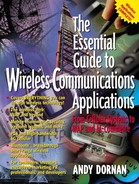Chapter 5. Third-Generation Standards
In this chapter…
Third-generation (3G) systems are critical to the wireless Internet services often touted as the future of mobile communications. At first, they will offer permanent access to the Web, interactive video, and voice quality that sounds more like a CD player than a cellphone. Many of their future applications are as yet unknown, with industry pundits saying that we will discover them as we go along.
The term 3G has become rather vague, but it was originally quite specifically defined as any standard that provided mobile users with the performance of ISDN or better—at least 144 kbps. Some of the earlier 21/2G standards, such as GPRS and IS-95b, might be able to do this, but only under optimal conditions. Third-generation systems need to provide ISDN speeds for everyone, not just for people equipped with the most expensive terminals and standing next to a base station.
Technologically, the increased capacity is found in part by using extra spectrum and in part by new modulation techniques that squeeze higher data rates from a given waveband. At the very lowest level, this new modulation works by abandoning computing's traditional binary system and replacing it with a system such as octal, which allows every symbol to have eight values instead of only two. They also tend to be based on CDMA rather than TDMA because of its better ability to cope with new users.
The arguments over 3G are a continuation of the earlier battles between PCS systems. Vendors, operators, and regulators all accept that the move towards higher data rates and better services will be evolutionary, as illustrated in Figure 5.1. Standards have to be backward compatible with their predecessors so that phones can maintain a connection while moving between cells based on the old and the new.
Europe has defined a type of CDMA that will work with GSM, which may or may not be compatible with a system already being built by Japan. Elsewhere, cdmaOne supporters are split between several types known collectively as cdma2000, none of which will interwork with the Japanese or European standard. In America, D-AMPS and GSM operators want to stick with TDMA. The result is a “federal standard,” more accurately described as a fudge. Global roaming will only be possible with special multimode phones.
Figure 5.1. Upgrade path to third generation

